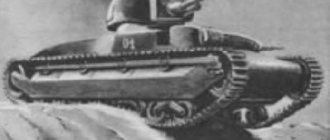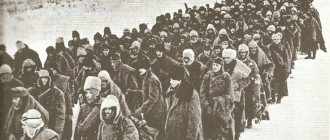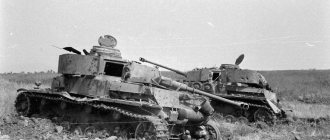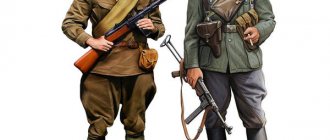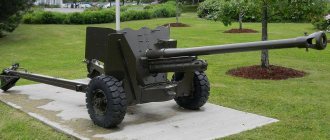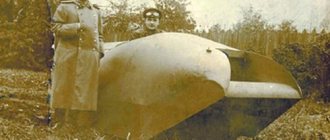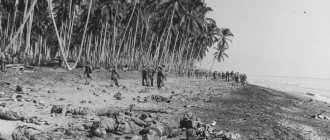Hello to all fans of the game World of Tanks! Now we will talk about the seventh level medium tank - the T-43, which is in one of the most popular upgrade branches and belongs to the nation of the USSR. It is through this machine that the path to the legendary T-54, T-62A and Object 140 lies.
This T-43 guide will be entirely dedicated to this tank, here we will look at the technical characteristics of the vehicle, talk about its strengths and weaknesses, decide which perks to upgrade to the crew on the T-43, etc.
TTX T-43 World of Tanks
Regarding the T-43, the review of the characteristics will be somewhat contradictory. The fact is that this ST is very similar to its predecessor, the T-34-85, and this similarity can be seen in many details.
For example, their armor is very similar, the T-43 has only 20 millimeters more armor in the hull and not significantly more in the turret. Even the speed and mobility of these tanks are the same, and the visibility differs by only 10 meters.
But don’t despair too much about the armor; rational tilts allow us to often catch ricochets, especially with the correct positioning of the body.
The only thing in which the T-43 is noticeably superior to its predecessor is its safety margin. Since we are a level seven tank, we should have slightly more HP. Otherwise, it’s worth saying that at the seventh level we get almost the same tank as at the sixth, but the opponents become stronger, but life is no easier.
Equipment
- Fan - increases the overall skills of the crew.
- With enhanced aiming drives, the aiming speed of the gun will increase noticeably. This will allow you to spend less time targeting the enemy’s vulnerable points.
- The presence of a medium-caliber gun rammer reduces reload time and increases the gun's rate of fire. Consequently, this increases the possibility of causing significant damage to the enemy.
gun
Looking at the gun on the T-43, we again notice some kind of catch, but the whole point is that this is the same gun that was on the T-34-85. Its only advantage was a slightly higher rate of fire, but this does not change matters. The penetration of the barrel is disgusting, the one-time damage is small, although the accuracy is quite good. What to do? How to break through the 8th and 9th levels? Everything is simple, in order to realize its 2000 damage per minute, which is the only good indicator of this tank, you will have to load gold shells, and only then the T-43 can show at least something in battles. Of course, you can and should try to drive into the enemy’s side or stern, then there will be enough penetration, but this does not always work.
The whole truth about the T-34. Shame on the tracks, or the worst tank of WWII
This photo clearly shows a precise hit to the bow beam. The shell went in like butter, despite the thickness of the armor in this area being 150mm.
The Soviet T-34 tank is well known to anyone interested in the history of World War II. Books, articles, documentaries, etc. present it as the all-conquering “Tank of Victory.” It was superior to all German tanks, had sloped armor, unprecedented mobility and was one of the main reasons why the USSR won on the Eastern Front.
How realistic are these claims? Was the T-34 the tank that really won the war? How does it compare to German and American tanks? If we try to answer these questions, conventional wisdom begins to change. Instead of a mechanical marvel, we get a poorly designed and manufactured tank that suffered horrendous losses against the "weaker" German tanks.
Revolutionary design of the T-34
The T-34 is considered by many to be the first tank to have sloped armor. This means that the tank's protection has been significantly improved compared to conventional armor at right angles. However, French tanks of the time such as the S-35 and Renault R-35 also had sloped armor.
Sloping armor also has disadvantages. For example, it seriously reduces interior space. Limited space not only affects the work of the crew, but also turns the T-34 literally into a steel coffin. An American study of the Korean War (analyzed the T-34/85, which was more spacious than the T-34/76) concluded that due to limited internal space, penetration of a tank's armor would typically lead to the destruction of the tank and the loss of the crew with 75% chance. For the Sherman, this figure was only 18% [1].
The German Pz.III and Pz.IV tanks generally had a conventional hull design, only partially using the slope in the middle part of the frontal armor. The new Panther tank was the first German tank to have fully sloped armor on the front and sides, but interior space was not as limited as the T-34.
The T-34 turret also suffered from lack of space. American experts who examined the T-34 at the Aberdeen training ground in 1942 about
Fuel tanks in the fighting compartment
Due to limited internal space, fuel tanks were located in the engine compartment and along the sides. The presence of fuel tanks inside the tank made any penetration of it fatal.
According to author Steven Zaloga in T-34-85 vs M26 Pershing: Korea 1950, page 23:
“Slanted armor paints only part of the picture of tank protection. The internal location of the fuel tanks plays a significant role in the vulnerability of the tank. The T-34-85 is a clear example of a compromise between the advantages and disadvantages of sloped armor. Although this armor reduced the likelihood of the tank being penetrated, it also led to a reduction in the internal volume of the hull. If it penetrated the T-34, the shell had a high probability of causing catastrophic damage to the tank by hitting the fuel tanks and ammunition stored in such a small space.”
In addition to the limited internal space, the T-34 also had a serious design flaw in the form of a two-man turret, as a result of which the commander was forced to also serve as a gunner. This severely limited the tank's combat effectiveness, as the commander could not concentrate on commanding the tank, but instead had to fire. A three-man turret was introduced on the T-34/85 in March 1944.
Armor spalls
The T-34 armor had a high Brinell rating. This means that it was effective in neutralizing anti-tank shells, but tended to flake off. Combined with manufacturing defects in the tank's design, this meant that the T-34's crew was in danger even if the tank was hit by shells that did not penetrate the armor.
The study "Review of Soviet ordnance metallurgy" on pages 3-5 reports:
“The armor of the T-34 tank, with some exceptions, was heat treated to a very high hardness (430-500 Brinell), probably in an attempt to provide maximum protection against armor-piercing shells, even at the expense of compromising the structural integrity of the armor. Some parts of the armor have surprisingly high strength given the very high hardness, but many areas of the armor are very brittle. Very high hardness is found in most Soviet tanks and its creation is a consequence of the assertion that high hardness armor has high resistance to penetration."
For projectiles whose caliber is equal to or less than the thickness of the armor, an increase in hardness leads to an increase in the speed required to penetrate or to a decrease in distance. If the caliber of the projectile exceeds the thickness of the armor, then the greater its hardness, the less projectile speed or greater distance is required.
Technical disadvantages
Christie pendant
The Christie suspension used on the T-34 had the advantage that the tank could reach high speeds on roads. Among the disadvantages, it is worth noting that it took up a lot of internal space and had poor maneuverability on rough terrain.
German tests in Kummersdorf (1 km hilly track) showed that the T-34 had poor results compared to the Pz. IV, "Tiger", "Sherman" and "Panther" [2].
According to the study "Engineering analysis of the Russian T34/85 tank", the main problem was the lack of shock absorbers.[3]
The Christie suspension was a technological dead end and the Aberdeen Proving Ground report states: "The Christie suspension was tested many years ago and was outright rejected."
Transmission
Another major problem was the bulky gearbox. It had low reliability and required excessive effort to change gears, which led to driver fatigue. The study “Engineering analysis of the Russian T34/85 tank” reports [4]:
“The difficulty of changing the gear (which did not have synchronizers) and the multi-plate dry clutch undoubtedly made driving this tank a very difficult and tiring task.”
The initially powerful V-2 engine (500 hp) could not be fully utilized due to the 4-speed gearbox [5]. Changing gears required excessive effort from the driver. On the T-34, it was possible to use 4th gear only on an asphalt road, so the maximum speed on a rough road, which was theoretically 25 km/h, in practice reached only 15 km/h, because to switch from 2nd to 3rd transmission required superhuman strength.
Later versions had a 5-speed gearbox, which made it possible to increase the speed over rough terrain to 30 km/h. However, even tanks built at the end of the war did not guarantee that they would have a new 5-speed gearbox. Tanks transferred to the Polish People's Army in late 1944 and early 1945 and tanks used by the North Korean army in 1950 had the old 4-speed gearbox [6].
Powerful gun?
The T-34 was armed with a large caliber gun. Initially it was armed with a 76mm L-11 cannon. It was soon replaced by the F-34 76 mm in 42 calibers, and the T34/85 was armed with the 85 mm ZIS S-53 in 54.6 calibers.
The numbers look impressive. After all, the main German tank of 1941-1943, Pz.III, had a 50mm cannon, and Pz.IV only received a satisfactory 75mm gun in 1943-1945. However, Soviet tank guns suffered from low speed, which led to poor penetration and accuracy at long ranges.
For example, the initial speed (in m/s) for Soviet guns [7] was: L-11 - 612 m/s, F-34 - 655 m/s (and when using German Pzgr39 shells - 625 m/s), ZIS S-53 - 792 m/s. Initial speed for German shells[8]: KwK 38 L/42 - 685, KwK 39 L/60 - 835 m/s, KwK 40 L/43 - 740 m/s, KwK 40 L/48 - 790 m/s, KwK 42 – 925 m/s.
Thus, the 75mm KwK 40, used for the Pz.IV and StuG from mid-1942, had much better penetration and accuracy than the F-34, and the Panther KwK 42 gun was also superior to the ZIS S-53 in the same areas.
No radio
Initially, only the unit commander had a radio in his tank. Radios were used more widely as the war progressed, but even in 1944 many tanks lacked walkie-talkies. The lack of communication meant that Soviet tank units acted with insufficient coordination.
Visibility issues
German reports indicate that the T-34s had serious difficulty navigating the terrain. This problem was partially solved during the war. The T-34 version of 1941 lacked the surveillance devices that were installed everywhere on German tanks. Such equipment allowed the commander to maintain a 360-degree view. The T-34's optics were also of poor quality.
The T-34 version of 1943 was equipped with a new turret of increased dimensions and a new commander's cupola, which had viewing slots around the perimeter and an MK-4 observation device in the rotating lid flap.
However, the quality of Soviet optics, combined with limited visibility, still left much to be desired. A report compiled by a German unit using the 1943 version of the T-34 stated [9]:
“The quality of sights in Russian tanks is significantly inferior to German designs. It will take a long time for German crews to get used to Russian sights. The ability to make an accurate hit through such a sight is very limited.
In Russian tanks, it is difficult to command a tank, much less a group of them, and at the same time perform the role of a gunner, so it is hardly possible to effectively control the fire of a group of tanks, as a result of which the firepower of the group is reduced. The commander's cupola on the T 43 simplifies tank command and firing; however, the view is limited to five very small and narrow slits.
Safe driving of the T-43 and SU-85 cannot occur with the hatches closed. We base this statement on our experience - on the first day of the battle on the Iasi bridgehead, four captured tanks of the division were stuck in a trench and could not free themselves, which led to the destruction of the weapons located in the trenches during an attempt to extract them. The same thing happened on the second day.”
Reliability issues
The T-34 was supposed to be a simple and reliable tank that rarely broke down. Many people like to compare it with more complex German tanks, which supposedly broke down often. The concept of the T-34 as a reliable tank is another myth of World War II.
Most tanks were lost in 1941 due to technical failure. The same reliability problems continued in the period 1942 - 1944. The evacuation and relocation of industrial facilities, combined with the loss of qualified personnel, only led to a drop in reliability.
In 1941, thirty-fours often had to carry spare parts for gearboxes with them [10]. In 1942 the situation worsened as many tanks could only cover short distances before breaking down. In the summer of 1942, Stalin issued an order [11]:
“Our tank forces often suffer more losses due to mechanical failures than in combat. For example, on the Stalingrad front, in six days, our twelve tank brigades lost 326 out of 400 tanks. Of these, about 260 were lost due to mechanical failures. Many tanks were abandoned on the battlefield. Similar cases can be observed on other fronts. Such a high level of mechanical failure is implausible and the Supreme Headquarters sees it as covert sabotage and sabotage by certain elements within the tank crews who are trying to exploit minor mechanical problems to avoid battle. From now on, every tank left on the battlefield due to alleged mechanical failures, and if the crew is suspected of sabotage, its members must be “demoted to infantry...”
Constant complaints from the front forced the authorities to investigate problems with the production of the T-34. In September 1942, a meeting was held at the Ural Tank Plant [12]. The meeting was headed by Major General Kotin, People's Commissar of the USSR Tank Industry and chief designer of the Kliment Voroshilov heavy tank. In his speech he said:
“...Having considered problems of an engineering and technological nature, I would like to discuss one more issue that has a direct connection with production shortcomings. They include: negligence and inaccuracy in the production process of tanks in factories, poor quality control. As a result, during combat use, our tanks sometimes break down before reaching the front line, or the crew is forced to leave the tanks in enemy territory due to some trifle... we must make sure that as a result of this meeting, all shortcomings will be identified and corrected as soon as possible…
Recently, Comrade Morozov and I visited Comrade Stalin. Comrade Stalin drew our attention to the fact that enemy tanks freely passed many kilometers of our lands, and although our vehicles are better, they have a serious drawback: after 50 - 80 kilometers they require repairs. This is due to the shortcomings of the chassis and also, as Comrade Stalin said, because of the drive, comparing the T-34 with the German Pz.III, which is in service with the German army, which is inferior in armor protection and other important characteristics, in the crew , and does not have such an excellent engine as the T-34, and the Pz.III engine is gasoline, not diesel.
Comrade Stalin gave instructions to the engineers, Comrade Comrade Zaltsman, and plant managers and ordered them to correct all defects as soon as possible. A special order was issued by the State Defense Committee, as well as directives from the People's Commissariat of the Tank Industry. Despite all these government resolutions adopted, despite repeated instructions from the army and the main directorate of tank forces, nevertheless, all these shortcomings have still not been eliminated... we must identify all the shortcomings, voice proposals for eliminating them and eliminate them as soon as possible, and also make proposals for modifying tank components that will make it better and faster..."
The situation remained problematic even in 1943-1944. The T-34 had constant problems with the gearbox and air cleaners. Aberdeen Proving Ground experts
The same problems were identified in the T-34/85, built in 1945. “Engineering analysis of the Russian T34/85 tank” notes [13]:
“Failure to operate engine air cleaners completely satisfactorily can be expected to lead to early engine failure as a result of excess dust and abrasive wear. After several hundred miles, there will likely be a reduction in engine performance as a result.”
The German unit that used the 1943 T-34/76 noted [14]:
“Even though our experience is limited, we can confidently say that Russian tanks are not suitable for long marches on roads and driving at high speeds. It turned out that the highest speed that can be achieved is from 10 to 12 km/h. It is also necessary while on the march to make at least 15-20 minute stops every half hour, allowing the tank to cool down. Difficulties and breakdowns of the steering clutch occurred with all captured tanks. In difficult terrain on the march, and during an attack, in which the attacking tank unit must often change direction, within a short time the side clutches overheat and become covered with oil ... "
Soviet tests of the newly built T-34 [15] showed that in April 1943 only 10.1% of tanks could travel 330 km; in June 1943 this figure dropped to 7.7%. The percentage remained below 50% until October 1943, when it reached 78%, after which it dropped to 57% the following month, and averaged 82% between December 1943 and February 1944.
A preliminary inspection of tanks manufactured at the Ural Tank Plant No. 183 (a major manufacturer of the T-34) showed that in 1942 only 7% of tanks had no defects, in 1943 14%, and in 1944 29.4%. In 1943, the main problem was damaged teeth.[16]
The engine also had serious reliability problems [17]. Depending on the manufacturer, engine life averaged 100 hours in 1941.[18] This figure was reduced in 1942, so some T-34s could not travel more than 30-35 km.
The T-34 that was tested at Aberdeen Proving Ground was built in the best Soviet factory using the best possible quality materials, but its engine stopped working after 72.5 hours. This did not happen due to American intervention - a Soviet mechanic (engineer Matveev), who was responsible for operation, was sent from Moscow with the tanks. The quality of these tanks was much better than conventional tanks as it covered a distance of 343 km. According to the head of the armored department of the Red Army, Fedorenko, the average mileage of the T-34 before major repairs during the war did not exceed 200 kilometers. This distance was considered sufficient, since the T-34's lifespan at the front was significantly shorter. For example, in 1942 it was only 66 km. In this sense, the T-34 was truly "reliable" because it was destroyed before it had the chance to break down.
T-34s failed in the middle and even towards the end of the war [19]. The Fifth Guards Tank Army in 1943 lost 31.5% of its tanks during the march to Prokhorovka. In August 1943, the 1st Panzer Army lost 50% of its tanks due to mechanical failures. In late 1944, tank units sought to replace engines with more than 30 hours of operation before an attack.
Production and losses during the war
Source: "Soviet Casualties and Combat Losses in the Twentieth Century"
Losses during the war amounted to almost 45,000 T-34 tanks! The total losses of Soviet armored forces in 1941-1945 amounted to 96,600 armored vehicles. This is not a typo. Almost a hundred thousand.
For comparison, Germany lost 15,673 tanks in the East in 1941-1944, and taking into account other armored vehicles (StuG, etc.) - 23,802.
“Waffen und Geheimwaffen des deutschen Heeres 1933 - 1945″[20]
Conclusion
The T-34 became a victim of Soviet and German propaganda. The German side often praised the T-34 in order to explain their defeats.
If the T-34 was as good as the propaganda made it out to be, then the T-34 should have led the USSR to great victories or at least to a turning point in the situation at the front already in 1941-1942. Instead, we see the opposite results of the activities of Soviet tank formations during this period. In 1943-1945, the T-34 was already obsolete, the Germans began to use updated versions of the Pz.IV and StuG III, equipped with powerful KwK 40, and of course, “Tigers” and “Panthers”.
The "best tank of World War II" suffered terrible losses against German armor, and even the updated version of the T-34/85 could not bridge the gap. According to a Soviet report [21], in the period from the summer of 1943 to March 1945, the probability of penetration of the T-34 armor by German tanks or anti-tank guns was 88-97%, thus, any shell that managed to hit was almost certainly piercing the armor
P.S. Thus, the T34 is not the best tank, but simply a tank of the fanatical religious faith of Russian quilted jackets, drilled from school into weak heads. And these heads cannot get stronger. How can they get stronger if they have been smoking, drinking and AUE since childhood?))
Leveling up the T-43 crew
In the case of the T-43, the crew also deserves special attention, and the choice of perks should be treated very carefully. To begin with, we take the commander, and upgrade the rest of the crew, which will allow us to leave the exposure in time, and in case of trouble, quickly restore disabled modules.
In the second stage, we will complete the repairs for the commander, and we will consider the skills of the other three tankers separately: • Gunner – ; • Driver mechanic - ; • Loader – .
As for the third stage of training, here all crew members, without a doubt, take it, designed to improve all characteristics as a whole. There is no point in describing further actions in terms of leveling up each perk, because it is unlikely that anyone will decide to ride the T-43 for so long, but otherwise the choice is yours.
Modules:
Turrets/guns
| Lv. | Tower | Armor (mm) | Rotation (deg/sec) | Review (m) | Weight, kg) | Price (credits) |
| VI | T-43 arr. 1942 | 80/80/80 | 48 | 360 | 7 000 | 12 840 |
Compatible weapons:
| Lv. | gun | Penetration (mm) | Damage (HP) | Rapid fire (rounds/min) | Spread (m/100m) | Mixing (c) | BC | Weight, kg) | Price (credits) |
| V | 122 mm U-11 | 61/140 | 450/370 | 5.26 | 0.57 | 2.9 | 36 | 1 600 | 45 920 |
| VI | 85 mm ZiS-S-53 | 126/167/43 | 160/160/280 | 12 | 0.42 | 2.9 | 60 | 1 550 | 62 000 |
| Lv. | Tower | Armor (mm) | Rotation (deg/sec) | Review (m) | Weight, kg) | Price (credits) |
| VII | T-43 arr. 1943 | 90/90/90 | 46 | 370 | 8 400 | 15 300 |
Compatible weapons:
| Lv. | gun | Penetration (mm) | Damage (HP) | Rapid fire (rounds/min) | Spread (m/100m) | Mixing (c) | BC | Weight, kg) | Price (credits) |
| V | 122 mm U-11 | 61/140 | 450/370 | 5.36 | 0.57 | 2.9 | 42 | 1 600 | 45 920 |
| VI | 85 mm ZiS-S-53 | 126/167/43 | 160/160/280 | 12.5 | 0.42 | 2.3 | 60 | 1 550 | 62 000 |
| VII | 85 mm D-5T-85BM | 144/194/44 | 180/180/300 | 11.11 | 0.37 | 2.3 | 48 | 1 850 | 73 600 |
Engines
| Lv. | Engine | Power (hp) | Fire probability (%) | Weight, kg) | Price (credits) |
| VI | V-2-34M | 520 | 15 | 750 | 29 500 |
| VIII | B-2-44 | 560 | 12 | 750 | 49 740 |
| VIII | V-54K | 600 | 12 | 750 | 58 000 |
Chassis
| Lv. | Chassis | Max. load (t) | Turning speed (gr/sec) | Rmin | Weight, kg) | Price (credits) |
| VI | T-43 | 34 | 36 | B/2 | 6 400 | 11 690 |
| VII | T-43 arr. 1943 | 37.3 | 38 | B/2 | 6 400 | 17 720 |
Radio stations
| Lv. | Radio station | Communication range (m) | Weight, kg) | Price (credits) |
| IV | 9Р | 325 | 80 | 1 980 |
| VIII | 9RM | 525 | 100 | 24 240 |
Tactics and use of the T-43 in battle
The T-43 medium tank in World of Tanks is a rather weak vehicle at its level, however, you can play it quite successfully if you act correctly. The main thing to remember is that we have fairly good mobility, not the largest silhouette, but weak armor penetration and one-time damage.
Judging by the numbers, the tank also has no armor, but rational bevels and tilts of the hull and turret quite often save us, ricochets fly at the most inopportune moments for the enemy, the main thing is to turn the hull and do not stand still.
Such characteristics make us a real support tank. Try to help your allies as much as possible, push directions together, change flanks, and if necessary, return closer to the base and help in its defense, since the speed of movement allows us to do this.
Regarding dealing damage, we work equally from the second line and from the front line. In both cases there is a severe lack of armor penetration, which means that we are heavily dependent on gold shells. Finally, it remains to say that the T-43 is worth taking, but not because this tank is very good, but for completing the branch and further access to really worthwhile, strong and interesting top-end vehicles of the USSR.
A little history
The T-43 tank was designed by the design bureau of plant No. 183 in 1942. The T-34 was taken as the basic basis using its structural elements. In this case, a certain improvement was made, since the T-34 hull was completely redesigned and a more compact placement of all existing mechanisms and components was made. As a result, the tank's protection was significantly increased (frontal armor - 75 mm). This significantly increased the survivability of the developed model in combat conditions. In the period from 08/19/1943 to 09/05/1943, as part of the “special tank company No. 100”, two prototypes of the T-43 were tested.
This is a reliable fact. During the battles, these tanks received from 1 to 11 enemy hits, but their armor was not penetrated. As a result, none of these samples were lost. After this, it was recommended to adopt the T-43 tank.
However, its serial production was not carried out. All factories were concentrated on the production of other machines. The sample in question is not very strong in terms of armor and guns, but some of its parts were used in other developments. For example, the chassis of this tank was installed on the more reliable T-44. Of course, attention was paid to the model in question, but not very much.
Order of studying modules:
| Chassis | Tower | gun | Engine | Engine | Radio station | gun | |
| Result: Credits: 284520 Experience: 74335 | |||||||
| T-43 arr. 1943 | T-43 arr. 1943 | 85 mm D-5T-85BM | B-2-44 | V-54K | 9RM | 122 mm U-11 | |
| 7960 experience - 17720 credits | 7105 experience - 15300 credits | 15500 experience - 73600 credits | 17,000 experience - 49,740 credits | 19,000 experience - 58,000 credits | 4040 experience - 24240 credits | 3750 experience - 45920 credits |
More details on the research.
- Chassis T-43 mod. 1943 - will add carrying capacity and also increase the maneuverability of the tank.
- Tower T-43 arr. 1943 - increases the viewing range, armor and will allow the installation of more powerful weapons.
- 85 mm D-5T-85BM gun - increases combat performance.
- Engines V-2-44 and V-54K - significantly increases dynamics.
- Radio station 9РМ - increases communication range.
- 122 mm U-11 gun - must be researched to obtain Elite status.
T25/2
American tank destroyer, successor to the T67 and M18 Hellcat sand guns, which at their levels are leaders in damage, win percentage and are very popular among players.
T25/2 loses even to them in a number of indicators:
- less DPM;
- worse mobility;
- lower stealth factor.
As for firepower, compared to the Hell, this anti-tank gun retained exactly the same one-time damage of 240 units, and armor penetration increased by only 10 mm. Therefore, after interesting gameplay and fun bending, switching to T25/2 players will be completely disappointed:
- Don’t take a position so quickly again;
- camouflage is no longer enough to shoot damage with impunity;
- the increase in firepower is so insignificant that it loses in average damage per battle not only to all classmates, but even to its predecessor at level 6.
The only thing that the T25/2 can boast of compared to other Tier 7 tank destroyers is its fast aiming, comfortable air-launchers, good visibility and a full rotation turret (albeit with a low traverse speed). Of course, the characteristics are important, but by no means primary for the class of tank destroyers.
This vehicle has one of the minimum one-time damage and the lowest armor penetration, so it is not capable of fulfilling its main role of causing damage.
Combat effectiveness
The main thing for a medium tank is speed and maneuverability. The T-43 does not have them. Insufficient thickness of the frontal armor and inappropriate angles do not provide adequate protection. The only way out for the T-43 is to fight from long distances, preventing the enemy from approaching you. Offensive support or defense is an effective use of a tank. He will not be able to survive in the front lines of the attack. Low driving characteristics practically make it impossible to “carousel” or “spin” heavy tanks. Your chance is to move with a group of allies. This tactic will be most effective when working as a team. The weak points of the T-43 are the fuel tank; the ammunition located in the rear of the turret explodes.
Battle tactics:
Scouts in the form of light tanks will not cause you any trouble. You will defeat them quickly. They are lightly armored. But they can’t penetrate your armor. You are required to be accurate, shooting ahead, i.e. the barrel is pointed slightly ahead of the target.
Medium tanks are your main opponents. The tactics are the same: don’t let them get close, aim at vulnerable spots. Such as: gun mantlet, side, stern, rear part of the turret, machine gun mantlets, triplex, viewing slits. Shoot down the tracks of particularly nimble targets, then they will become easy prey for your artillery.
Heavy tanks remain quite dangerous opponents. It’s very difficult to win without “carouseling” them. Keep your distance. Hit vulnerable spots. High-explosive fragmentation shells are good at knocking down tracks, that is, if the armor is too tough for you.
PTs prefer to use cover and bushes. They are well armored, especially in the later levels. During a one-on-one fight, go around the PT from behind or to the side. By leaning into the enemy's body, you will not allow him to turn and shoot at you. If you are covering an attacking group, stay in your position and support with fire. T-43 - support tank.
Self-propelled guns are a rather rare enemy for the T-43. Medium tanks do not often survive to the end of the battle. There is not enough speed to quickly get to the enemy base. But if you are faced with enemy artillery, deprive the enemy of his main firepower. Load high-explosive fragmentation shells and hit them while driving around the self-propelled guns. Don't let them turn to face you. Your tank is not designed to accurately hit a powerful cannon.
